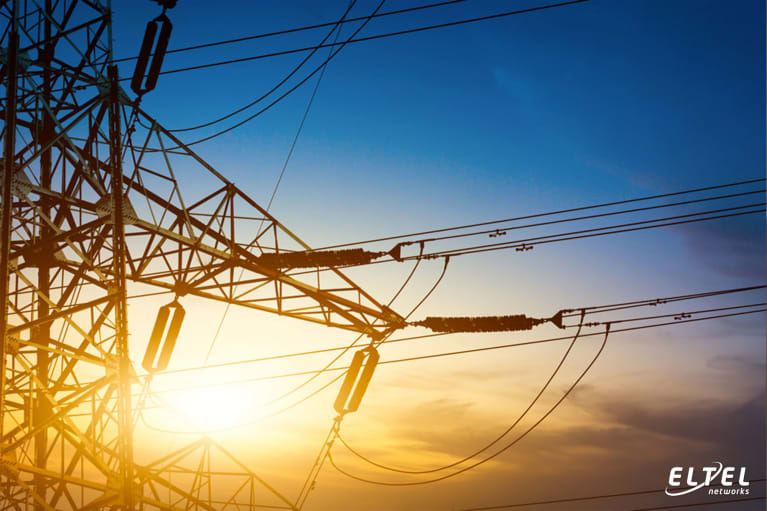
Power lines photo created by evening_tao - www.freepik.com
In the previous entries (part 1, 2, 3), we described the most important terms in the field of the electrical power engineering we deal with at Eltel Networks in Poland. Today is the last part of the electrical power engineering glossary including, but not limited to, the types of high-voltage and extra high-voltage networks, the types of metering and settlement systems and the information on the neighbouring countries with which Poland is trading on the capacity market.
Balancing Market - the market for the purchasing/selling energy by the transmission system operator to match demand and supply. The price of energy in the Balancing Market is based on the transactions concluded for which the bids are made by energy producers. This market is relevant because the entity involved in the electricity trading is not always able to adjust the supply or consumption of energy to the contract in force during the relevant period.
Networks - combined and co-operating systems for the transmission or distribution of electricity, owned by a power company or a distribution company.
Distribution network - a high-, medium- and low-voltage power network whose traffic is the responsibility of the distribution system operator.
Extra high-voltage (EHV) network - an electric power transmission network where the potential difference between phase conductors is equal to or greater than 200 kV. With increasing demand for electricity, the EHV transmission lines with a voltage of up to 1.1 MV are constructed - such systems are already available, for example, in Japan. Long-distance energy transmissions result in higher power losses because they are proportional to the square of the electric current passing through the conductor. To reduce losses, lines with a higher operating voltage are designed for strategic long systems.
Read also the article Design of overhead lines - step-by-step process
Transmission network - an extra high- or high-voltage power network whose traffic is the responsibility of the transmission system operator. In Poland, the operator of the National Power Grid is Polskie Sieci Elektroenergetyczne.
High-voltage (HV) network - an electric power transmission network where the voltage between phases is from 60 to 200 kV (in Poland, 110 kV). This network is used to transmit electricity over long distances.
High Voltage Direct Current (HVDC) Network - a HV direct-current transmission network.
With use of the high-voltage direct current (HVDC) technology to transmit current over long distances (over 500 km through overhead lines and over 50 km through submarine cables), the transmission of direct current is more cost-effective. In this method, prior to transmission, the current is passed through the rectifier, and then, on the consumer’s side, it is passed through the inverter that converts direct current into alternating current. At present, both the rectifier and the inverter are most often the same semiconductor converting system that can operate in both modes depending on the energy transmission direction.
The submarine HVDC cable linking Poland and Sweden was launched in August 2000. The converter station is located near Ustka on the Polish side and near Karlshamn on the Swedish side. In addition, the interconnection of the power systems of Poland and Lithuania was launched in December 2015. The converter station is situated on the Lithuanian side. The coupling of both systems has closed the so-called “the Baltic ring” and allows energy to be transferred between the previously unsynchronized systems. There are works in progress on the next HVDC connection through the submarine cable to Lithuania under the “Harmony Link” project.
Read more about HVDC in our article Advantages vs disadvantages of HVDC power transmission

Power lines photo created by evening_tao - www.freepik.com
Insulator fittings used in the high-voltage power engineering in Poland
Seller - a power company whose business activity is selling the electricity produced by itself or a power company whose business activity is trading of electricity.
Sales of electricity- direct sales of energy by the generation entity or resale of energy by the trading entity.
Field controller - a field terminal that has built-in push buttons or a touch screen to control the switches and allows the current status of the switches in this field to be visualized.
Power system - power networks and equipment and installations connected to them and cooperating with the grid.
Medium voltage - voltage higher than 1 kV and lower than 110 kV.
Metering and control system - a measuring system whose indications form the basis for monitoring the accuracy of the metering and settlement systems by comparing measured values and/or balancing power plants or grid areas.
Metering and settlement system - meters and other measuring or measuring and accounting equipment, in particular: active energy meters, reactive energy meters and current and voltage transformers, as well as connection systems between them, used, directly or indirectly, for metering electric energy and settlement of charges for that energy.
Primary metering and settlement system - a metering and settlement system whose indications form the basis for the quantitative and financial settlements of capacity and electric energy.
Reserve metering and settlement system - a metering and settlement system whose indications form the basis for the quantitative and financial settlements in the event of malfunction of the primary metering and settlement system.
Equivalent metering and settlement system - a metering and settlement system whose indications form the basis for the quantitative and financial settlements of capacity and electric energy.
Protective system - a set consisting of one or more protective devices and other auxiliary equipment designed to perform one or more specific security functions.
System user - an entity that supplies electric energy to or is supplied from a power system.
Volt - the unit of voltage.
Emergency stop - automatic or manual shutdown of equipment in the event of a safety hazard to this equipment or other equipment, installations and networks, or a safety hazard to persons, property or the environment.
Residual-current device (RCD), residual-current circuit breaker (RCCB) or ground fault circuit interrupter (GFCI) - an electrical safety device that breaks an electrical circuit when it detects that the current flowing out of the circuit is not equal to the current flowing in. It is to protect from electrical shock by direct and indirect touch and reduce the effects of damage to the equipment, including the possibility of a fire.
Want to learn more about electrical safety devices? Read our article Electrical power equipment - types and classification of protection
Inter-system exchange - exchange of capacity and electricity between NPG and other power systems. At present, the national system in Poland holds parallel exchanges with the following systems:
Czech Transmission System Operator (ČEPS) - Polish-Czech transmission
Slovak Electricity Transmission System (SEPS) - Polish-Slovak transmission
50 Hertz Transmission GmbH - Polish-German transmission
and non-parallel exchanges with the following systems:
Svenska Kraftät (SvK) - Polish-Swedish transmission (Poland-Sweden DC link)
NEK Ukrenergo - Polish-Ukrainian transmission
Litgrid - Polish-Lithuanian transmission
Producer - a power company that produces electricity.
Connector - a point of connection to the grid or installation that is provided with primary protections and often also a meter.
Summary of the terms used in the electrical power engineering, Part 4
This is the fourth and last part of our glossary of the terms and issues relating to the electrical power engineering. If you are interested in previous entries, read the parts 1, 2, 3. We hope that our publications allowed you to better understand the processes in the electrical power engineering both in Poland and abroad.
Author: Piotr Wyrzykowski
